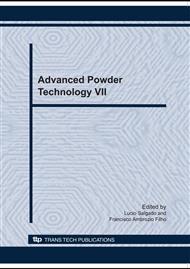p.916
p.922
p.928
p.936
p.943
p.948
p.954
p.959
p.965
Synthesis of Ni-Zn Ferrite Catalysts by Combustion Reaction Using Different Fuels
Abstract:
The aim of this work is to evaluate the effect of different fuels in the preparation of Ni-Zn ferrites by combustion reaction. The catalysts were prepared according to the propellants chemistry, in stoichiometric composition, using a vitreous silica container. Carbohydrazine, monohydrated citric acid and glycine fuels were used. During the synthesis parameters as flame combustion time and temperature were measured. The structural and morphological characteristics of the powders were evaluated by XRD, textural analysis by nitrogen adsorption and SEM. The fuel monohydrated citric acid presented the greatest time and temperature of combustion reaction. The results show that the type of fuel changed the final characteristics of the powders. The XRD results showed the formation of Ni-Zn ferrite phase for all fuels used in this study. The powders prepared with carbohydrazine resulted in largest value of surface area. All powders showed morphology constituted by soft agglomerates of nanoparticles.
Info:
Periodical:
Pages:
943-947
Citation:
Online since:
October 2010
Keywords:
Price:
Сopyright:
© 2010 Trans Tech Publications Ltd. All Rights Reserved
Share:
Citation:


